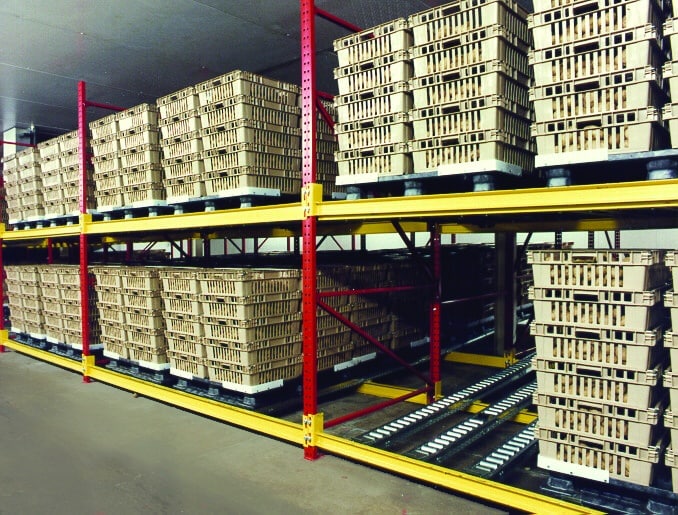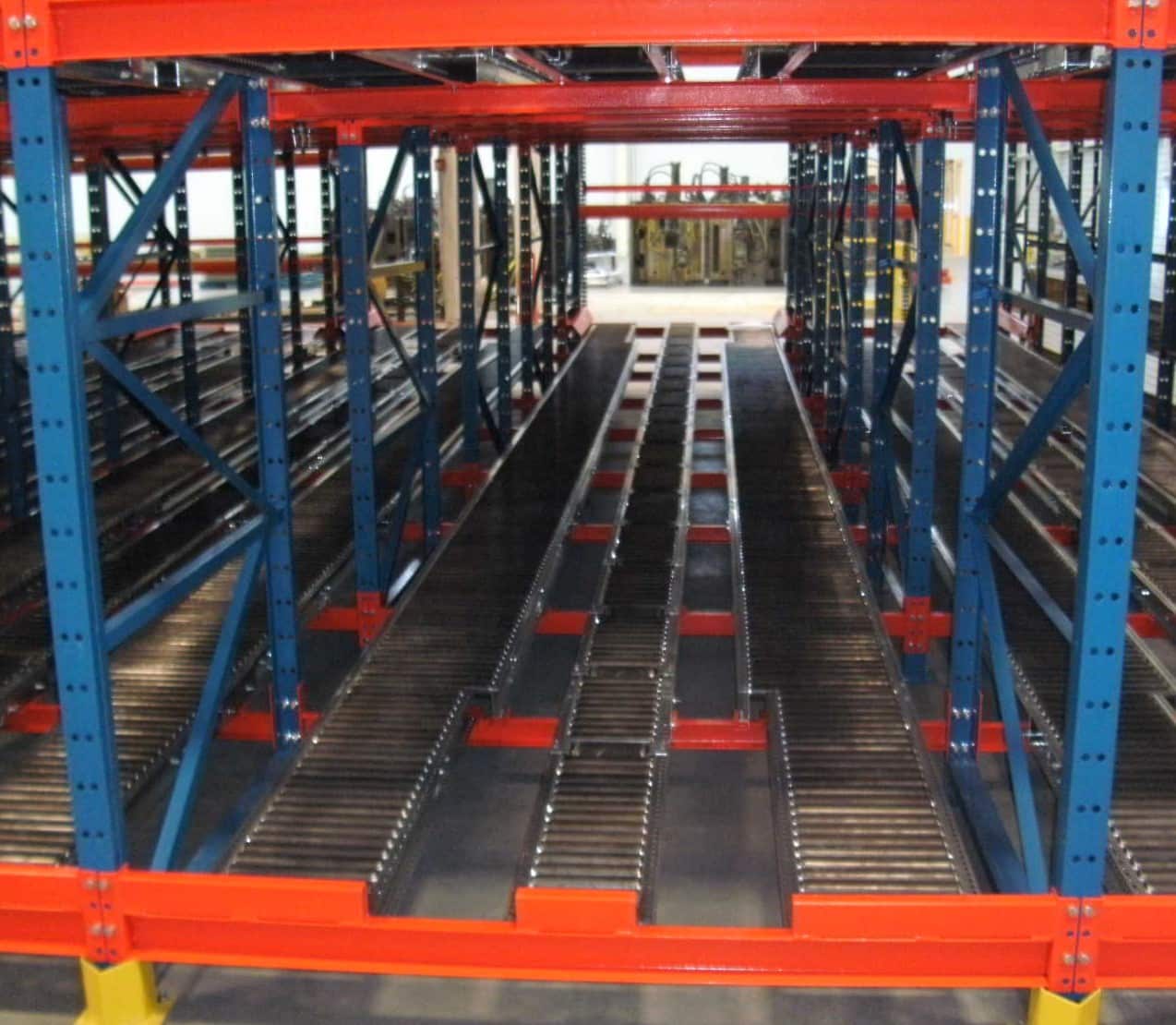Improve Warehouse Efficiency With Pallet Flow Racks
Posted on Sep 7, 2021
When properly designed to meet the specific inventory and storage requirements, pallet flow racks maximize storage space and improve shipping logistics.
Any warehouse or distribution center with limited floor space that needs high-density storage or automatic rotation of inventory on a first-in, first-out (FIFO) basis can benefit by implementing pallet flow storage racks. However, achieving the full performance capabilities of this type of rack system requires careful planning and implementation. When properly designed to meet the specific inventory and storage requirements, pallet flow racks improve warehouse efficiency, maximize storage space, and improve shipping logistics. Without it, the system may underperform expectations.
What Is A Pallet Flow Rack?

Pallet flow storage rack provides FIFO inventory control
Simply defined, this type of racking system is designed so that when the pallet in front is removed by a forklift, the pallets behind gently “flow” forward to replace it. Inclined tracks, rollers, and brakes – with an assist from gravity – are used to accomplish this task. New inventory is then loaded at the back end of the rack, facilitating FIFO product rotation, which is particularly valuable for items with expiration dates.
In this type of “dynamic” racking approach, goods can be stored 3, 10, or even 20 pallets deep and on multiple levels. This eliminates the need for wide aisles between every row of traditional “static” racks required for forklift access and maneuverability. By storing more palletized goods in less space, facility managers can dramatically increase the amount of inventory in a specific warehouse footprint or, on the flip side, reduce the amount of space required for new warehouse construction.
Utilizing Pallet Flow Rack Systems to Your Advantage
Compared to traditional fixed racking, a high-density pallet flow system can essentially cut the required square footage for a warehouse in half. The savings can be significant in terms of reduced property and building costs. There are substantial logistical benefits to using a dynamic rack system as well.
A pallet flow rack can drastically reduce the labor required to pick pallets because a forklift is only needed for the initial loading of the pallets as well as final unloading. With static racks, forklifts must travel further down aisles and often must spend time rearranging inventory to access the correct items.
When a large number of pallets with a single product SKU are routinely loaded into trucks, locating the pallet flow rack near the loading dock can also minimize the distance that forklifts travel to as little as 20 feet each way, which speeds material handling. Even pallets with varied SKUs that are being shipped to the same location can be located near each other to further speed truck loading.
Designing to Meet Specific Requirements
Although the concept of a pallet flow rack may seem straightforward, installing a system that optimally meets a specific warehouse’s requirements takes some planning and collaboration with the vendor.
Many people think you can take pallet flow rack components off the shelf and ship them out the door. But, it must be designed to accommodate your specific requirements: pallet types, pallet weights, forklift capacity, facility layout, and any other restrictions. Some racking distributors are willing to supply a price quote without fully understanding the requirements of the application. Not every vendor asks questions to find out what the user needs.
The process ideally begins by understanding the facility’s dimensions, obstructions, types of inventory and forklifts, as well as truck loading and shipping requirements. It is vital to building the flow rack to take advantage of your warehouse’s full height, width, depth, and floor plan. Obstructions like low ceilings or the location of sprinklers, building columns, doors, lights, and vents must be built around.

Pallet flow rack essential for managing time-sensitive products in high-density storage areas
It is also important to consider the brand, lift height, and a weight capacity of the forklifts used at the facility. In general, a forklift’s lift and push/pull capabilities diminish the higher it raises a pallet. A forklift can cost as much as $100,000. So you want to be sure your new pallet flow racks work with the ones you have, or you could have to acquire new forklifts.
In terms of tailoring a pallet flow system to an application, it is necessary to plan for efficient flow storage, loading/unloading, and transport. Forklift travel distance can be minimized with proper pallet flow planning. You don’t have to travel hundreds of feet to pick a pallet. If you install the pallet flow rack in the ideal location, you may only have to travel twenty feet to pick a pallet. When you return, the next pallet is waiting. This minimizes labor as well as speeds loading and unloading.
Similar planning should be applied to storage depth. Just because the system can be designed 20 pallets deep, doesn’t mean it should be. Instead, it should be designed and grouped to simplify loading/unloading, as well as optimal product rotation.
Even some aspects that might seem like smaller details, such as the type of pallet, are important because they affect how pallets “flow” in the system. There are too many types of pallets with different dimensions today and it could affect the type, and cost, of the pallet flow rack, required. So, it’s not enough to design on the assumption that a standard 40” or 48” pallet will be used. If the actual pallet has different dimensions, it could increase costs significantly.
Get In Touch
With all the aspects that must be considered to get the best results from your flow rack, it can be helpful to work with a vendor that provides one point of contact for planning, coordination, answering questions, troubleshooting, and resolving any issues. This is far simpler than interacting with a separate pallet flow manufacturer, rack manufacturer, as well as dealer, and installer.
Given sufficient planning and coordination, pallet flow racking systems can be one of the most space-efficient and cost-effective forms of material handling for warehouses and distributors. If you have questions on how to improve warehouse efficiency, get in touch with us today.
